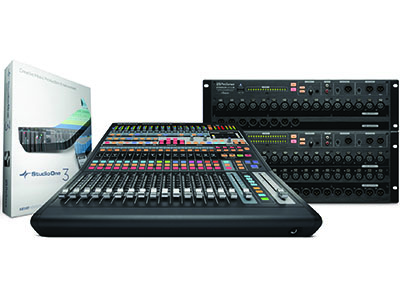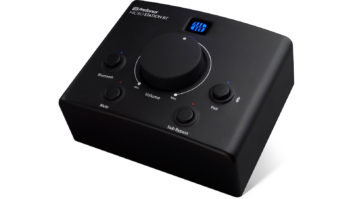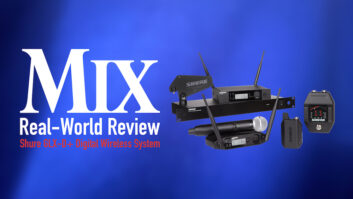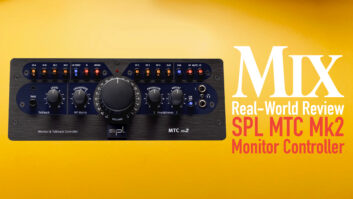
A few years ago, the idea of affordable networked digital audio was a pipe dream, yet continuing advances in digital audio technology permit exactly that. The StudioLive AVB48AI Mix System from PreSonus offers the expandability and scalability of networked audio in a variety of configurations that can not only be managed using a hardware mix controller, but also by using a variety of wireless devices. The subject of this review is the StudioLive AVB48AI; several smaller, and one larger system configuration are also available.
The StudioLive AVB48AI Mix System consists of three main components: the StudioLive CS18AI control surface ($1,699.95), and StudioLive RML32AI and RML16AI mixers ($2,299.95 and $1,499.95, respectively). The RMLs are essentially mixing consoles without a work surface and inherently require external control via the CS18AI or PreSonus UC Surface software for iOS, Mac or PC (the software is free of charge). Each RML has a front-panel USB port that accepts a memory stick, or a WiFi adapter. Using PreSonus’ USB WiFi adapter and UC Surface software running on my iPad, I was able to wirelessly control one RML within minutes.
As you might gather from the model number, the RML32AI is a 32-in x 16-out system in a rackmount stage box. The front panel is home to the analog I/O, with the first 24 analog inputs employing XLR jacks and remaining eight as mic/line Combo jacks. All preamps are the company’s recallable XMAX discrete, Class A type, designed for low noise, transparency and wide frequency response. Mix buses are output on 16 XLRs; separate XLR jacks with level controls are provided for the Main L/R and Mono outputs.
Other front panel connections include an RCA stereo Tape Input, Stereo Phones output with volume control and Main or Cue output selector, 32 LED channel meters that can be switched to show phantom power status, and an All Mute button. On the rear panel are an S/PDIF output, two FireWire 800 ports, a CAT5 port for network control or AVB, and DB25 outputs that duplicate the 16 front-panel Mix outputs, facilitating connection of IEM transmitters. The RML16AI is identical save for the reduced number of inputs (16) and outputs (8).
Each RML’s 64-bit DSP engine provides input trim, polarity reverse, HPF, dynamics (gate, comp and limiter), and 4-band parametric EQ for each input channel. All Mix outputs feature gate, compressor, limiter, 4-band parametric EQ, and a 31-band graphic EQ, though the Main L/R and Mono Bus lack the Gate. The 31-band graph has a “Draw” option, whereby you can use your finger to create an EQ curve..
Hardware Control
The CS18AI complements operation of the RMLs or functions as a DAW controller for PreSonus Studio One 3 or Capture software (though it wasn’t the focus of this review, I tried the CS18AI with Capture and Studio One 3. Operation of both DAWs was enhanced using the CS18AI). It has two Combo and two TRS inputs, plus two analog outputs; when the CS18AI is situated at front-of-house, these jacks provide a convenient means to connect a talkback microphone, a stereo background music system, and perhaps another mic for house announcements. Two XLR outputs and a headphone jack route the Main, Solo or Cue Output. When using the CS18AI as a monitor mix controller, those outputs can feed cue wedges or IEM systems.
In addition to 16 motorized channel faders, the CS18AI includes a Master L/R fader and a “Flex” fader that is assigned to a Mix when that Mix is selected. This made it easy to mute a monitor send, or raise/lower the overall level of a mix while still having channel sends to that mix on the faders. Channel parameters are accessed by selecting a channel, then using the “Fat Channel” controls to access preamp, EQ, dynamics and aux send levels.
The CS18AI can route two distinct types of information: control data or audio via AVB connection. To create a system where the CS18AI was used simply as a control surface, I connected it to a single RML using a CAT5 cable. This type of configuration (or using a standard Ethernet switch) does not support networked audio. That’s where AVB comes into play. Connecting the CS18AI and an RML to an AVB network hub enables them to share audio (PreSonus recommends a MOTU AVB Hub). When I cued up a monitor Mix on the CS18AI, it routed that Mix from the RML through the surface and into my cue speaker. When using AVB, the control data lives happily on the network with the audio.
Adding another RML is where things get really interesting—but beware of jumping down the rabbit hole because very soon the question changes from, “What can this system do?” to, “What do you want this system to do?” It’s possible to control two independent RMLs from a single CS18AI, selecting one of them at a time from the CS81AI’s Mixer Control screen. But once the two RMLs were recognized on the network, the Cascade option became available, enabling me to create a a single 48-in/16-out “system.”
Sorry, you don’t get to augment the output capability, but the Mix outputs on the “slave” RML mirror the Mix outputs on the master RML. Setting up Cascade required a trip to the Mixer Cascading Reference Manual. Once I had it configured properly, the CS18AI displayed additional layers of audio inputs, numbered 33 to 48 (analog), plus another 16 inputs that could be sourced from the network or via FireWire. Working with a track act, you could have 48 analog inputs from the stage along with 16 prerecorded tracks running from your DAW software.
If that doesn’t blow up your skirt, you can connect a wireless router to the AVB. I used an iPad running UC and an iPhone running QMix-UC to control all 64 inputs(!). The CS18AI acts as a “master of permissions” for the wireless devices, allowing complete or limited control for an iPad, or iPhone. QMix-UC for iPhone supports PreSonus’ Wheel of Me, whereby the user can be given a simple “more me” monitor mix, or can be allowed access over multiple channels, or even multiple mixes. Given access to multiple mixes on my iPhone, I could walk a stage while a band was playing and dial in the monitor mix for each musician. When setup was complete I could restrict permissions so that each musician controlled only their own mix.
FX and More
Incorporated into the RML mixers are four independent stereo effects engines, designated FXA, FXB, FXC and FXD. The first two are dedicated to reverb while the second two are dedicated to delay effects. There are no modulation or pitch effects. My favorites were the Plate Reverb and Large Hall (lovely for vocals) and the Small Hall for snare drum. There’s no EQ on the FX return channels, and I missed that feature because I typically EQ my effects quite a bit, though I found the Filter Delay helpful in this regard for vocals. There’s a bit of a glitch regarding the FX Returns in Cascade mode: effects sent from channels on the slave mixer cannot be muted, even though effects sent from channels on the master mixer can be muted. PreSonus is aware of this and has already implemented a fix that will be incorporated in the next RML firmware revision.
I checked the RML for compatibility as a FireWire interface with Digital Performer, Pro Tools and Reason, all of which easily recognized and communicated I/O options with the RMLs. Some of the networking setup—particularly when adding a wireless router to the AVB router—was a bit challenging due to the variety of configurations that could be created and the IP address requirements for network communication. PreSonus offers plenty of documentation on its website and in the StudioLive Software Reference Manual to help facilitate the process. Once I had the networking sorted I could control the two RMLs using my MacBook, iPad, iPhone or the CS18AI—simultaneously, if necessary. If your future plans include Dante networking, the AVB interface card can be replaced with an optional Dante card.
Of course, all of this audio muscle would be useless if the RML32AI and RML16AI didn’t sound good—and they do. The XMAX mic pre’s are clean and quiet, the mix buses have plenty of headroom, and the EQ is useful. If you’re using a laptop connected to an RML via FireWire, you also have options to run SMAART RTA or Spectragraph in the background while mixing.
All of the components seem to be robustly constructed yet maintain compact packaging. Add that to the scalability of the system and its ability to be controlled using a variety of wired or wireless controllers, and it’s almost scary what the AVB48AI Mix System can do.
Steve La Cerra is a N.Y.-based live and studio engineer.







